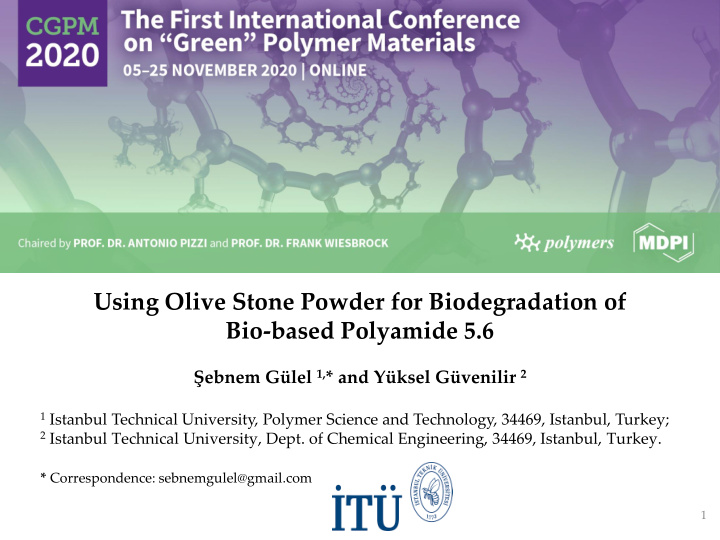



Using Olive Stone Powder for Biodegradation of Bio-based Polyamide 5.6 Şebnem Gülel 1, * and Yüksel Güvenilir 2 1 Istanbul Technical University, Polymer Science and Technology, 34469, Istanbul, Turkey; 2 Istanbul Technical University, Dept. of Chemical Engineering, 34469, Istanbul, Turkey. * Correspondence: sebnemgulel@gmail.com 1
Abstract: Polymers are extensively used advanced materials. The most common polymers in industry are non-biodegradable and petroleum derived. The increasing demand for these types of polymers brings along the problem of accumulation of plastic waste in the environment and depletion of fossil resources. At this point, biodegradability of polymers gains great importance as well as bio-based polymers produced from renewable resources. In this study, bio-based polyamide 5.6 polymer (PA56) was incorporated with olive stone powder (OSP) in order to manufacture a biodegradable polyamide compound, and its degradability was investigated. The olive stone powder was incorporated into polyamide 5.6 at 10% (w/w) with a twin screw extruder in order to manufacture the compound, PA56/OSP10. The characterization of the PA56/OSP10 compound was done using Fourier transform infrared (FTIR) spectroscopy. The biodegradability of the PA56/OSP10 compound was examined through a natural soil burial test which lasted for 6 months. The sign of degradation was assessed by both weight loss measurements and visual observations. At the end of 6 months, 5.24% weight loss and surface deformation were determined for the PA56/OSP10 compound. These results suggest that olive stone powder can be considered as a green alternative to conventional biodegradation additives for polymer compounding. Keywords: biodegradability; olive stone powder; bio-based; polyamide 5.6; compounding. 2
Bio-based Polyamide 5.6 Figure 1. Polycondensation reaction of polyamide 5.6 * Olive Stone Powder * Kyulavska, M., Toncheva-Moncheva, N., & Rydz, J. Biobased Polyamide Ecomaterials and Their Susceptibility to Biodegradation. In Handbook of Ecomaterials ; Martínez, L. M. T. et al., Eds.; Springer: Cham, Switzerland, 2017; pp. 2901 – 2934.
Compounding and Sample Preparation 4
Fourier Transform Infrared (FTIR) Analysis Figure 2. The FTIR spectra of the PA56/OSP10 compound and the polyamide 5.6 5
Biodegradability Natural Soil Burial Test Figure 3. Recovered weight (%) versus burial time (days) graphs of PA56 and PA56/OSP10 Table 1. Weight loss percentages of the neat polyamide 5.6 and PA56/OSP10 compound PA56 Content OSP Content Weight Loss % Materials (wt. %) (wt. %) after 6 months PA56 100 % 0 % 0.26 % PA56/OSP10 90 % 10 % 5.24 % 6
Biodegradability Figure 4. The images of; ( a ) Unburied Polyamide 5.6; ( b ) Polyamide 5.6 after 6 months of soil burial (sample 1); ( c ) Polyamide 5.6 after 6 months of soil burial (sample 2); ( d ) Unburied PA56/OSP10 compound; ( e ) PA56/OSP10 compound after 6 months of soil burial (sample 1); ( f ) PA56/OSP10 compound after 6 months of soil burial (sample 2). 7
Conclusions A novel bio-based polyamide compound, PA56/OSP10, was successfully manufactured. PA56/OSP10 compound showed 5.24% (w/w) degradation at the end of 6 months. Surface deformations, abrasions and discolorations were also observed. Olive stone powder can be considered as a green biodegradability additive for the bio-based polyamide 5.6 polymer. 8
Acknowledgments This work was supported by Research Fund of the Istanbul Technical University. Project Number: 42182. Thank you for your attention. 9
Recommend
More recommend